On June 15, 1902 this notice appeared in the Fort Worth Register:
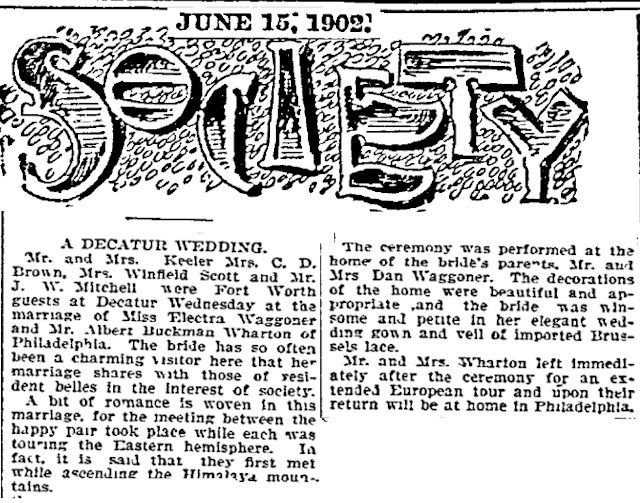 On June 11 Electra Waggoner, daughter of cattle and oil millionaire W. T. Waggoner, had married Albert Buckman Wharton of Philadelphia after the two had met while “ascending the Himalaya mountains.” The marriage was performed in Decatur at El Castille, the mansion built in 1883 by Electra’s grandfather Dan as the headquarters of the sprawling Waggoner Ranch. (The Register account erroneously referred to Mr. and Mrs. Dan Waggoner—parents of W. T.—as Electra’s parents. They were her grandparents. Dan would die three months later.) After a tour of Europe the newlyweds lived in Philadelphia while W. T. Waggoner built his daughter the $46,000 ($1.1 million today) “honeymoon cottage” at 1509 Pennsylvania Avenue. (Today we call that “cottage” “Thistle Hill.”)
On June 11 Electra Waggoner, daughter of cattle and oil millionaire W. T. Waggoner, had married Albert Buckman Wharton of Philadelphia after the two had met while “ascending the Himalaya mountains.” The marriage was performed in Decatur at El Castille, the mansion built in 1883 by Electra’s grandfather Dan as the headquarters of the sprawling Waggoner Ranch. (The Register account erroneously referred to Mr. and Mrs. Dan Waggoner—parents of W. T.—as Electra’s parents. They were her grandparents. Dan would die three months later.) After a tour of Europe the newlyweds lived in Philadelphia while W. T. Waggoner built his daughter the $46,000 ($1.1 million today) “honeymoon cottage” at 1509 Pennsylvania Avenue. (Today we call that “cottage” “Thistle Hill.”)
And thus began one of the most-prominent marriages of Fort Worth society at one of the most-recognized addresses in one of the most-storied neighborhoods in Fort Worth history: Quality Hill.
Late in the nineteenth century as the city of Fort Worth had expanded beyond the site of the Army fort, the city’s first enclave of affluence had been along Samuels Avenue northeast of the courthouse. Today few of the early grand houses of Samuels Avenue survive. Fort Worth’s next enclave of affluence in the early twentieth century was Quality Hill southwest of downtown. (The word Quality in this usage means “aristocracy.” Mark Twain, for example, had used the term the quality to refer to the well-to-do as early as 1885.)
 By 1899 the Register was referring to Fort Worth’s enclave of affluence, centered along Summit Avenue, as “Quality Hill.” (Hill Street would be renamed “Summit Avenue.” The “Mr. Slaughter” referred to was cattleman John Bunyan Slaughter, who lived at 556 South Summit Avenue. See Part 2.)
By 1899 the Register was referring to Fort Worth’s enclave of affluence, centered along Summit Avenue, as “Quality Hill.” (Hill Street would be renamed “Summit Avenue.” The “Mr. Slaughter” referred to was cattleman John Bunyan Slaughter, who lived at 556 South Summit Avenue. See Part 2.)
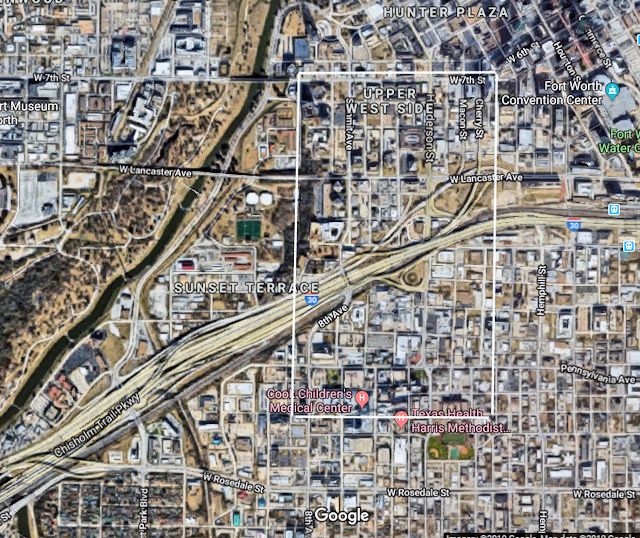
Early in the twentieth century a disproportionate amount of Fort Worth’s wealth and power was concentrated on Quality Hill. It was an area of only one-third square mile: from College Avenue west to 9th Avenue and from West 7th Street south to Pennsylvania Avenue.
Quality Hill was the home of Cowtown’s movers and shakers, the princes of the city’s boardrooms and ballrooms. The better-remembered of them—Samuel Burk Burnett, W. T. Waggoner, Winfield Scott—made millions in cattle, oil, banking, real estate. They were the stuff of Texas stereotypes, the J. R. Ewings and Jett Rinks of the real world.
 Samuel Burk Burnett and W. T. Waggoner
Samuel Burk Burnett and W. T. Waggoner
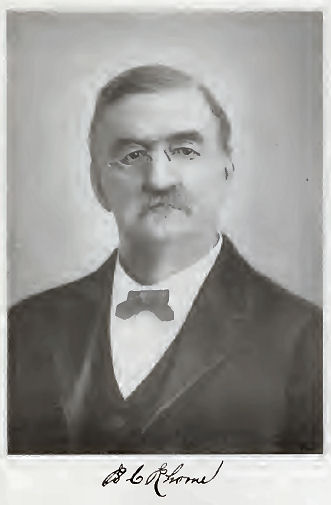
Byron Crandall Rhome
Some residents of Quality Hill were so prominent that they are remembered today in place names. The city of Rhome in Wise County was named for cattleman Byron Crandall Rhome (1024 Penn Street). The town of Burkburnett in Wichita County was named for—you guessed it—cattleman Samuel Burk Burnett (1424 Summit Avenue) by President Theodore Roosevelt, who had visited the area to participate in a wolf hunt hosted by Burnett. Burnett Memorial Park was donated by Burnett in memory of his son. Cobb Park is named for Horace H. Cobb (1119 Penn Street). The West 7th Street Bridge technically is the “Van Zandt Viaduct,” named for Major Khleber Miller Van Zandt (800 Penn Street). The town of Electra is named for Electra Waggoner. Winscott Road in southwest Tarrant County was named for Winfield Scott (1509 Pennsylvania Avenue).
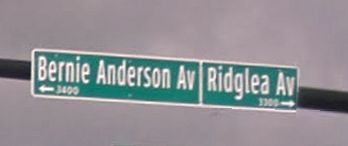 Bernie Anderson Avenue leading into Ridglea Country Club was named for the man whose house is featured in Part 2. Anderson and brother-in-law Morris Berney operated the golf course that evolved into Ridglea Country Club. William Capps (1120 Penn Street) has a streets named for him. Capps Park also was named for William Capps.
Bernie Anderson Avenue leading into Ridglea Country Club was named for the man whose house is featured in Part 2. Anderson and brother-in-law Morris Berney operated the golf course that evolved into Ridglea Country Club. William Capps (1120 Penn Street) has a streets named for him. Capps Park also was named for William Capps.
And a few residents of Quality Hill built or bought buildings (Burnett, Waggoner, Scott) that bear (or bore) their name.
And Burk Burnett was not the only resident of Quality Hill to socialize with presidents. The daughter of the late Joseph B. Googins, Swift packing plant manager of 1101 Penn Street, in 1933 became the father-in-law of President Franklin Delano Roosevelt’s son Elliott. Daughter Ruth had met Elliott at the stock show.
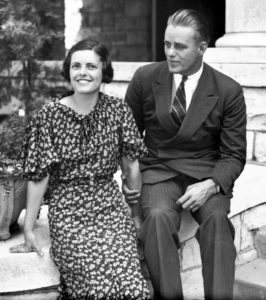
For the most part, the movers and shakers of Quality Hill were not men who had been born with a silver spoon in their mouth (although one—George Reynolds—long carried an iron arrowhead in his back). Two of the most successful (Burnett and Waggoner) had begun their careers as cattle trail cowboys; another (Reynolds) had begun as a Pony Express rider; and still another (Scott) had begun as an illiterate woodchopper and died as Fort Worth’s biggest taxpayer.
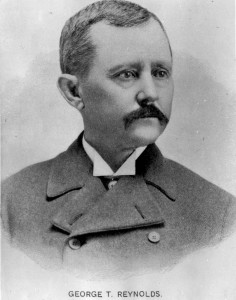
George Reynolds
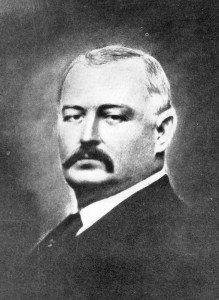 Winfield Scott
Winfield Scott
Some residents of Quality Hill—such as Burnett, Waggoner, and Scott—became so wealthy that they could scarcely keep their names out of the headlines. Others lived quietly, out of the headlines. But whether they lived in the headlines or in the shadows, the residents of Quality Hill lived well: in large, lavish homes staffed by cooks, chauffeurs, gardeners, and other household employees. (More than forty Quality Hill homes are shown in Part 2 and Part 3.)
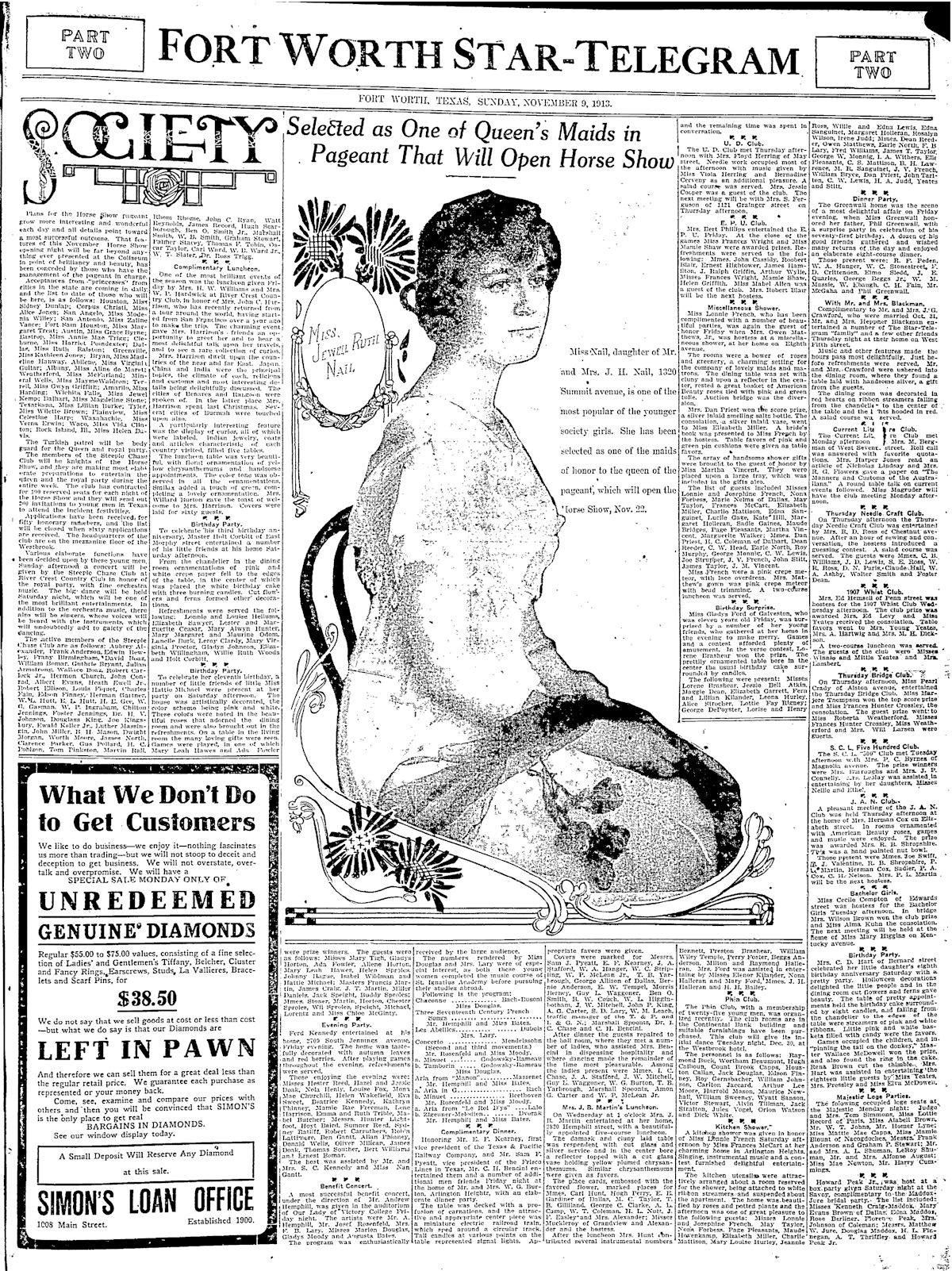 For the residents of Quality Hill summers might be spent in Europe; children might be sent “back east” or even to Europe for schooling. Daughters were debutantes and queens and maids of various social events. This Star-Telegram clip from 1913 features Jewell Ruth Nail, daughter of cattleman James H. Nail of 1320 Summit Avenue as one of the queen’s maids in the horse show pageant.
For the residents of Quality Hill summers might be spent in Europe; children might be sent “back east” or even to Europe for schooling. Daughters were debutantes and queens and maids of various social events. This Star-Telegram clip from 1913 features Jewell Ruth Nail, daughter of cattleman James H. Nail of 1320 Summit Avenue as one of the queen’s maids in the horse show pageant.
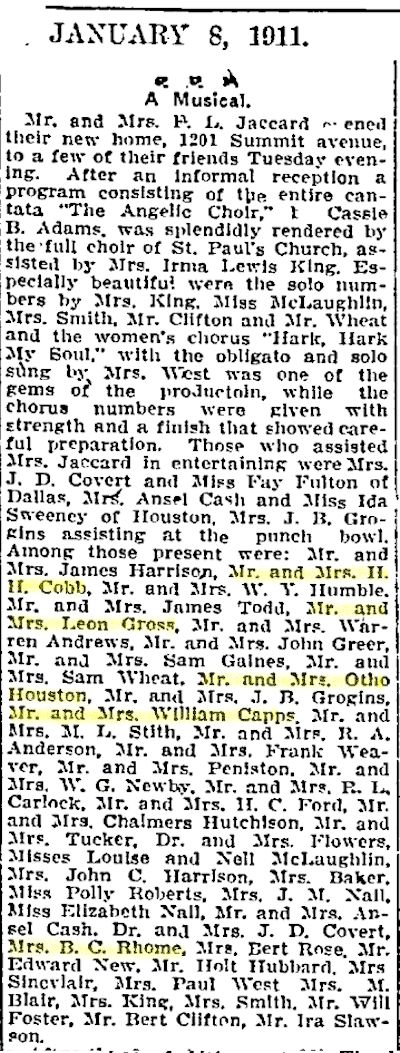 The residents of Quality Hill mingled at work and at play: They often were directors of the same banks and insurance companies, attended dances and parties and recitals at each other’s homes. They shared boxes ringside at horse shows, played cards and croquet at the country clubs. This Star-Telegram clip from 1911 announces the opening of the F. L. Jaccard house at 1201 Summit Avenue. I have highlighted among the dozens of guests some of the Jaccards’ Quality Hill neighbors.
The residents of Quality Hill mingled at work and at play: They often were directors of the same banks and insurance companies, attended dances and parties and recitals at each other’s homes. They shared boxes ringside at horse shows, played cards and croquet at the country clubs. This Star-Telegram clip from 1911 announces the opening of the F. L. Jaccard house at 1201 Summit Avenue. I have highlighted among the dozens of guests some of the Jaccards’ Quality Hill neighbors.
Fort Worth’s affluent moved in a small social circle, and Quality Hill presented a fairly small dating pool. Not surprisingly, sometimes its residents intermarried. For example, Hyde Jennings of 1131 Summit Avenue married Florence Van Zandt, daughter of Major Khleber Miller Van Zandt of 800 Penn Street.
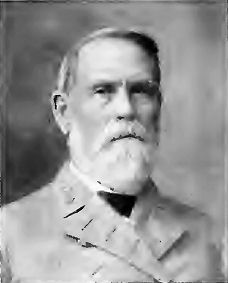
Major Khleber Miller Van Zandt
Fort Worth was enjoying its heyday as “Cowtown” early in the twentieth century, and Burnett, Waggoner, and Scott weren’t the only men on Quality Hill who knew bulls as well as they knew bullion. Other Quality Hill cattlemen included John Bunyan Slaughter, C. A. O’Keefe, Cass Edwards, brothers William and George Reynolds, George B. Loving, Franklin Hayes McFarland, Fountain Goodlet Oxsheer, and James H. Nail.
Other residents of Quality Hill were doctors (Joseph R. Pollock, Scurry Terrell, Harold Warwick). Dr. William A. Duringer of 1402 Summit Avenue was president of the medical school of Fort Worth University. Others were lawyers (James W. Swayne, Romulus John Rhome, Newton Hance Lassiter, Leroy Albert Smith). Samuel Benton Cantey Jr. joined the law firm that his father and William Capps had founded in 1882. It is Fort Worth’s oldest continuously operating law firm.

Dr. William A. Duringer
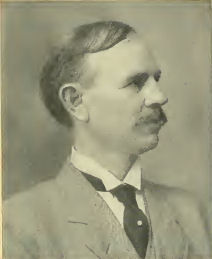 William Capps
William Capps
Still other residents of Quality Hill were business executives. They made their fortune in banking (Robert E. Harding, W. H. Eddleman, Otho S. Houston, Khleber Miller Van Zandt, C. H. Silliman, H. C. and W. R. Edrington, H. B. Herd, G. E. Cowden), cotton (Neil P. Anderson, Bernie L. Anderson, Herman Frerichs, T. B. Owens), wholesale groceries (Edmund M. Schenecker), furniture and carpet (Thomas B. Ellison), insurance (Jesse T. Pemberton), real estate (James F. Moore and Woodson L. Ligon), and bricks (Horace H. and Lyman Cobb). Colonel Robert Dickie Hunter made his fortune in coal and bricks. William Thomas Fakes in 1876 opened a furniture store that also sold coffins.

Horace H. Cobb
One Quality Hill resident—John P. King at 1204 Presidio Street—was a candyman. Another—Louis B. Weinman at 1311 Pennsylvania Avenue—designed houses for the affluent, including at least two houses (C. A. O’Keefe at 520 South Summit Avenue and James F. Moore at 1326 Pennsylvania Avenue) on Quality Hill. A. B. Wharton, husband unto Electra Waggoner at 1509 Pennsylvania Avenue, was a man of vision: In 1904 he opened one of Fort Worth’s first auto liveries (automobile dealerships).
And just down the street at 1251 Pennsylvania Avenue, inspiring all the residents of Quality Hill to live long lives, was George L. Gause, Fort Worth’s first trained undertaker.
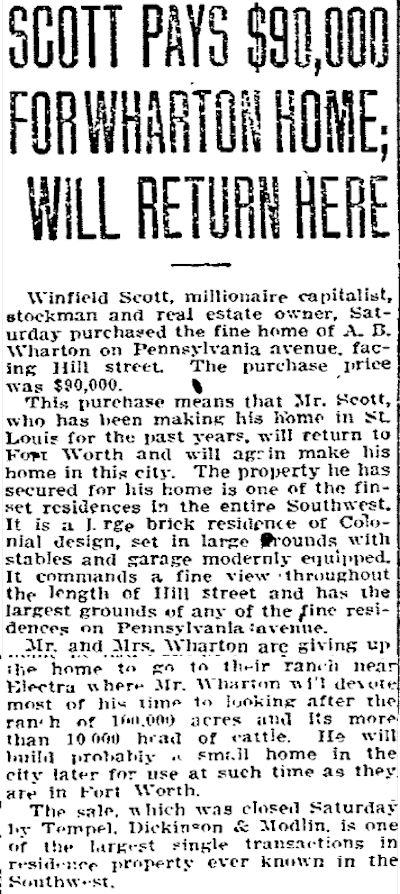 As for A. B. Wharton and wife Electra, they left their Quality Hill neighbors in 1911, moving to Wichita County, where the town of Electra was named for her. A. B. Wharton would help run the legendary Waggoner Ranch. Winfield Scott, himself a cattleman, bought the Wharton house for $90,000 ($2.2 million today). (Hill Street, remember, would be renamed “Summit Avenue.”) Clip is from the February 12, 1911 Star-Telegram.
As for A. B. Wharton and wife Electra, they left their Quality Hill neighbors in 1911, moving to Wichita County, where the town of Electra was named for her. A. B. Wharton would help run the legendary Waggoner Ranch. Winfield Scott, himself a cattleman, bought the Wharton house for $90,000 ($2.2 million today). (Hill Street, remember, would be renamed “Summit Avenue.”) Clip is from the February 12, 1911 Star-Telegram.
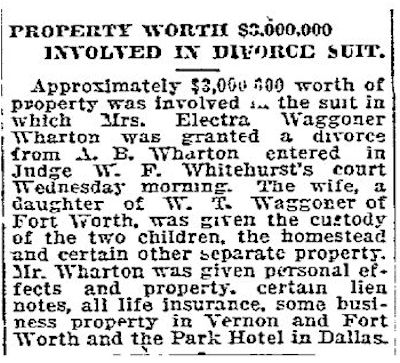 Alas, the marriage that had begun with a notice in the society section in 1902 ended with a notice in the news section in 1921 when Electra Waggoner and Albert Buckman Wharton split the sheets. And they split some pretty pricey sheets: $3 million would be $38 million today. Clip is from the January 27, 1921 Dallas Morning News.
Alas, the marriage that had begun with a notice in the society section in 1902 ended with a notice in the news section in 1921 when Electra Waggoner and Albert Buckman Wharton split the sheets. And they split some pretty pricey sheets: $3 million would be $38 million today. Clip is from the January 27, 1921 Dallas Morning News.
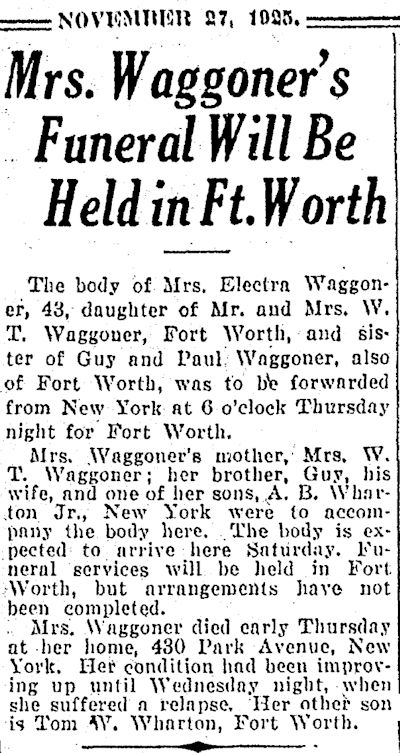 By the time Electra Waggoner Wharton died in 1925 she had moved on again: She died in her Park Avenue home in Manhattan. Albert Buckman Wharton died in Simi Valley, California in 1963.
By the time Electra Waggoner Wharton died in 1925 she had moved on again: She died in her Park Avenue home in Manhattan. Albert Buckman Wharton died in Simi Valley, California in 1963.
Today W. T. and Electra Waggoner, as well as several other residents of Quality Hill, including Neil P. and Bernie L. Anderson, Khleber Miller Van Zandt, Winfield Scott, Samuel Burk Burnett, James F. Moore, and John Bunyan Slaughter, are once again neighbors—in Oakwood Cemetery.
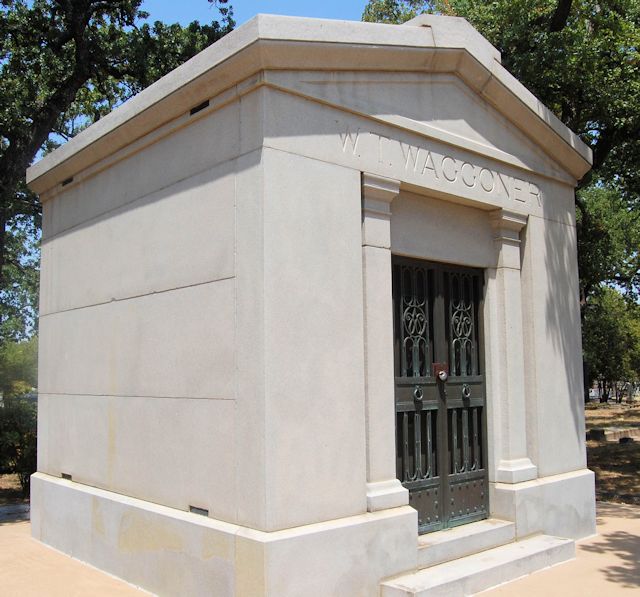
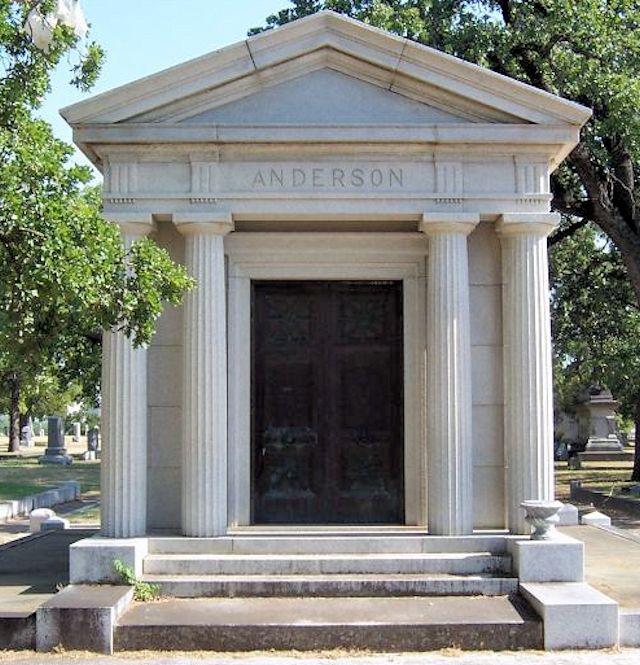

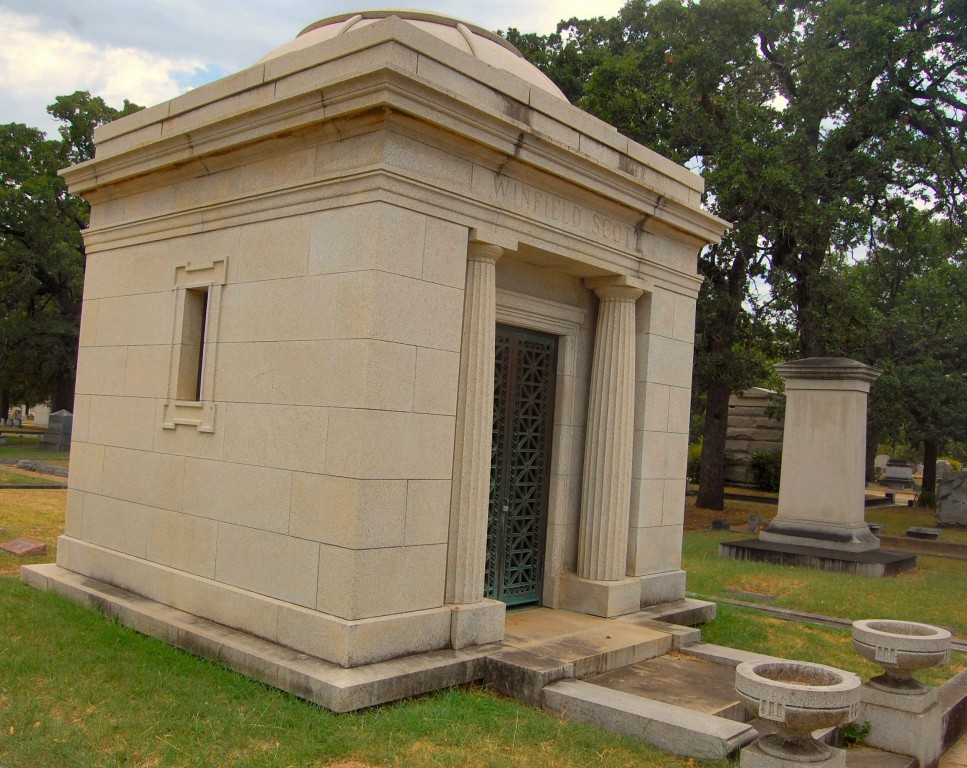
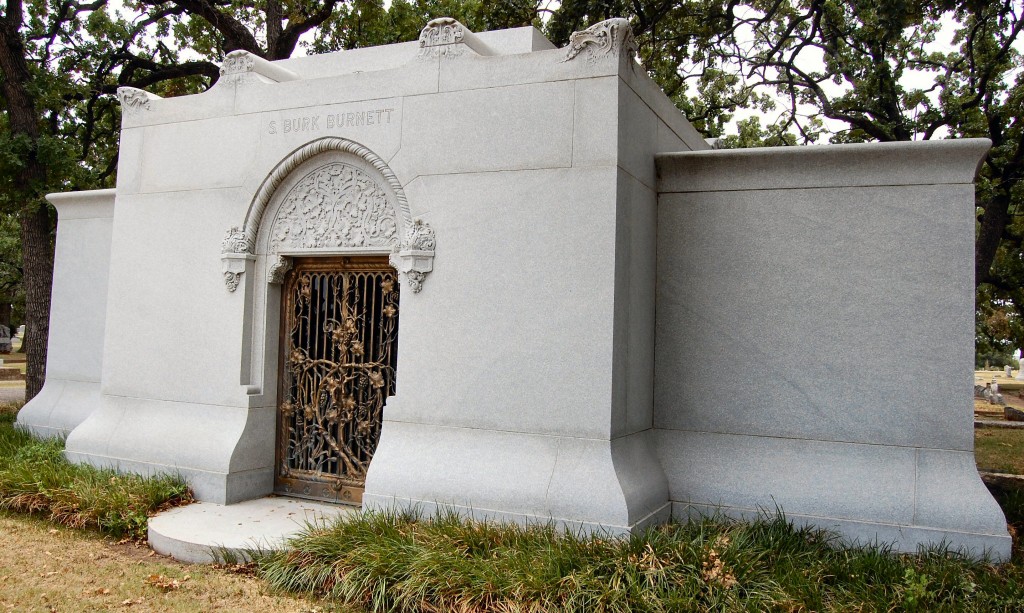
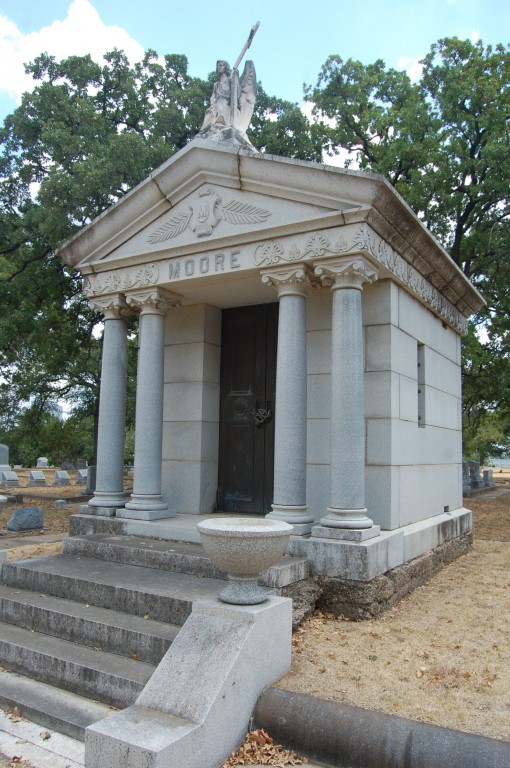

Silk Hats and Spats (Part 2): The Residences of Quality Hill (Demolished)
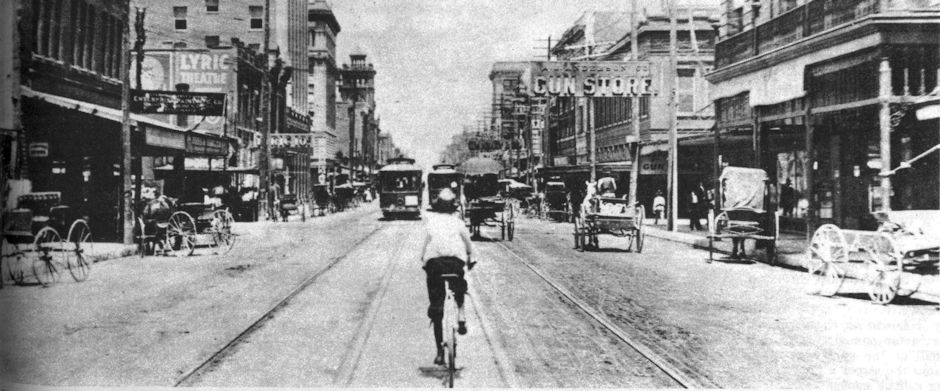





BC Rhome’s grandson Rob Rhome was a Rotary friend of my husband when we lived in Houston.
The Rhome brothers certainly lived very interesting–and very different–lives.